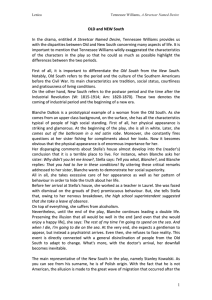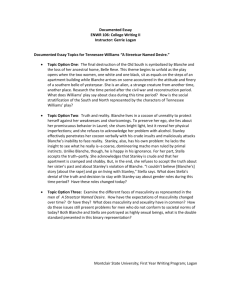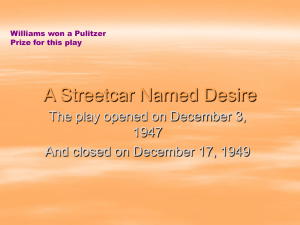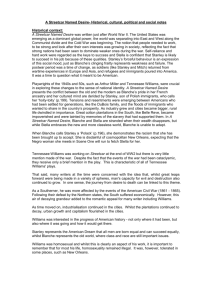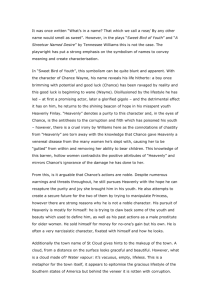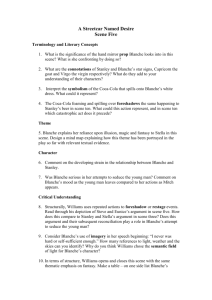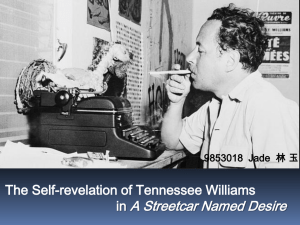A Streetcar Named Desire Play In Comparison With - john
advertisement
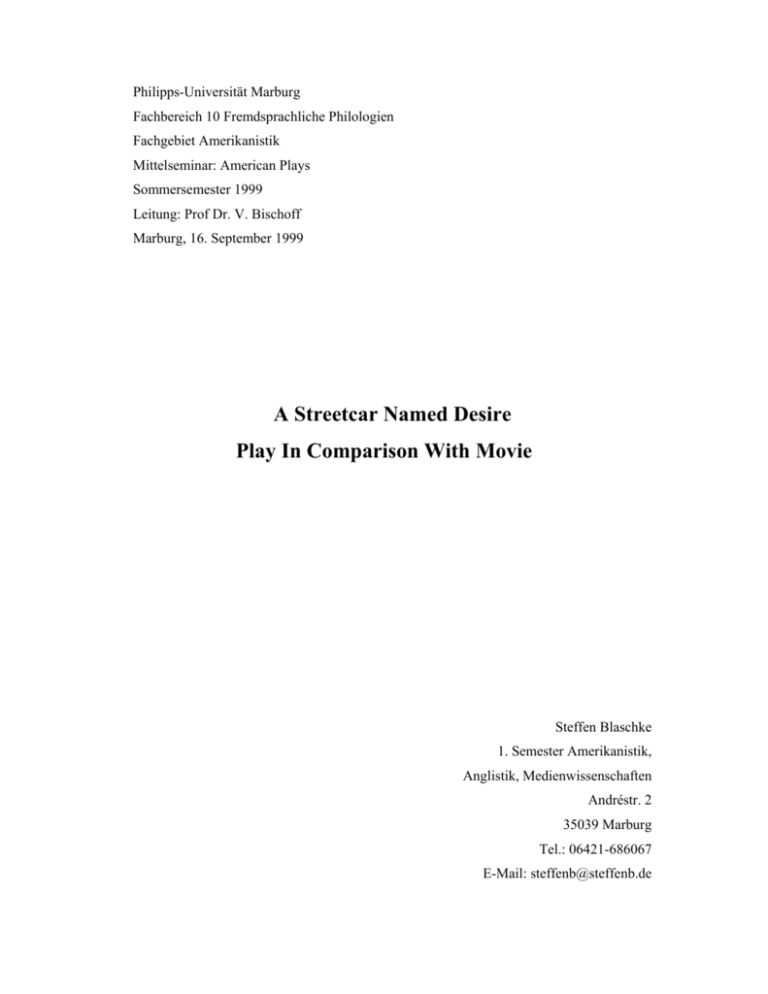
Philipps-Universität Marburg Fachbereich 10 Fremdsprachliche Philologien Fachgebiet Amerikanistik Mittelseminar: American Plays Sommersemester 1999 Leitung: Prof Dr. V. Bischoff Marburg, 16. September 1999 A Streetcar Named Desire Play In Comparison With Movie Steffen Blaschke 1. Semester Amerikanistik, Anglistik, Medienwissenschaften Andréstr. 2 35039 Marburg Tel.: 06421-686067 E-Mail: steffenb@steffenb.de Table Of Contents 1 Introduction ...............................................................................................................3 2 Similarities.................................................................................................................3 2.1 General Similarities...............................................................................................3 2.2 Actors and Crew....................................................................................................4 2.3 Plot and Words ......................................................................................................5 3 Differences ................................................................................................................7 3.1 General Differences...............................................................................................7 3.2 Censorship .............................................................................................................8 3.3 Homosexuality.......................................................................................................9 3.4 Rape and Punishment ..........................................................................................10 3.5 Smaller Moral Differences ..................................................................................11 4 Conclusion...............................................................................................................12 2 1 Introduction A Streetcar Named Desire was written by Tennessee Williams in his mid-thirties and first staged in New York on December 3 1947. Just as his first play, The Glass Menagerie, produced only two years earlier, Streetcar was a huge success and stabilized Williams’ position among the most respected and influencing playwrights in modern theater. It was also his first production to be turned into a movie and because of the highly emotional plot and the superb actors it became a blockbuster on the “big screen”. Williams takes the audience to New Orleans where the relationship of Blanche DuBois, her sister Stella and brother-in-law Stanley is being illuminated. The following look on the similarities and differences between the play and the film version will give an in-depth view on the essential points, although it is by no means an overall interpretation. 2 Similarities 2.1 General Similarities “A movie based on a Tennessee Williams play is a Tennessee Williams film“ Forster Hirsch said (Phillips 223). One can only agree with this statement, its evidence is undisputed. Furthermore he adds that “The Williams films retain the spirit of the original play, especially, as in the case of Streetcar, when Williams himself worked on the screenplay. His personality still dominates the film version“ (Phillips 223). Williams was one of the dramatists who would go to every rehearsal of his play and sit in the audience just to be there and watch closely how things went. He never interfered a great deal, because many directors had their own way of interpreting the plot. Contrary to all expectations he found in Elia Kazan an excellent director who was not only willing, but was indeed dependent on the cooperation of the playwright. Streetcar was their first production together and later they became close friends. Just as the play had been a huge success on the stage, earning several awards, among others the Pulitzer Prize and the Drama Critic’s Circle Award, the movie was a box- 3 office success and won several Academy Awards as for best actress, best supporting actress and actor and many more. 2.2 Actors and Crew In 1947 Tennessee Williams had seen Elia Kazan’s production of Arthur Miller’s All My Sons, and was so impressed by the staging of the drama that he wanted him as director for Streetcar. At first Kazan resisted this idea, but his wife, an old friend of Williams, read the play and eventually won her husband over for the job (Williams, Tennessee, Memoirs 130). The casting of the two leading actors was somewhat difficult. Kazan dispatched the twenty-three-year-old Marlon Brando to Cape Cod, where Williams was staying for the summer, and wanted him to read the part of Stanley. Brando was in Kazan’s “beginners” class and had never been playing any major characters so far, but as Williams got to meet him, three days later then he was expecting him, Brando was immediately given the role of Stanley Kowalski. “I never saw such a raw talent in an individual“ Williams wrote afterward (Hayman 119). The opposite role to Stanley, Blanche DuBois, was given to Jessica Tandy, who had been playing Portrait Of A Madonna, a one-act play also by Williams, which was directed by her husband Hume Cronyn. Later he recalls in his memoirs that “it was instantly apparent to me that Jessica was Blanche” (Williams, Tennessee, 132). As the two most important roles were cast, Williams told Kazan he should take care of the other parts as he wished. Kim Hunter as Blanche’s sister Stella and Karl Malden as Mitch were chosen without any notice. With just one exception most of the original members of the stage production remained the same and had to repeat their roles in the film version of A Streetcar Named Desire directed also by Elia Kazan. This change in cast was the role of Blanche, who was originally taken by Jessica Tandy. Vivien Leigh, who had been playing Blanche in London, directed by her present husband Laurence Olivier, had gotten the vote to star in the screenplay. The movie was shot in a short period as all of the actors had been performing their roles countless times on stage. Kazan later remembers that “it was difficult to get involved in it again, to generate the kind of excitement which I had had 4 for the first time around. The actors where fine – but for me it was marrying the same woman twice; you know that there won’t be any surprises this time” (Phillips 229). At first Leigh had trouble with Kazan; she told him that her role of Blanche intended by her husband differed from the one he had on his mind, but he unmistakably made clear that she was either to follow his lead or leave. She agreed and became enthusiastic (Williams, Dakin 179). Although Leigh was a British actress, she was to take again the role of a southern gentlewoman, just as about ten years before in Gone With The Wind, and undeniably the southern twang suits her well. Her interpretation of Blanche made a strong impression on critics and it won her the Oscar for best female in a leading role. Brando was the perfect counterpart and he transferred his explosive performance from the stage to the screen. Unfortunately he lost the Academy Award to Humphrey Bogart staring on the side of Katherine Hepburn in African Queen this year. Nevertheless it was the beginning of the road to success for Brando. He never went back to the stage but gave his breakthrough performance four years later in The Wild One, which finally made him a movie star. As already mentioned Kazan and Williams became close friends over the years. They worked together on several other productions like Cat On A Hot Tin Roof, to name just one. Kazan was awarded an Oscar for his lifetime achievement this spring, but critics were divided into two sides, one praising his tribute to modern theater and film and the other pointing to doubtful involvement of his in anti-communistic affairs during the McCarthy era. In any event, his work as a director is inviolable. 2.3 Plot and Words If the words in the play and in the movie are compared one recognizes that they are – with few exceptions due to reason we will discuss further below – almost identical. The same observation can be made by looking at the plot of the movie, which closely follows the structure of the play. Streetcar’s eleven scenes make a perfect script for the stage as well as for the screen. Kazan tried to stay as close to the original production as possible, although he thought about opening up the movie for the “big screen”, which is usually a good approach. He turned down this attempt after rehearsing scenes outside 5 New Orleans, which showed Blanche leaving Belle Reve and moving into the city. Kazan said: I filmed the play as it was because there was nothing to change. I have no general theory about opening out a play for the screen; it depends on the subject matter. Streetcar is a perfect play. I did consider opening out the play for the screen initially, but ultimately decided to go back to the original play script. It was a polished script that had played in the theater for a year and a half (Phillips 225). The depressing narrowness of the Kowalski apartment was transferred from the stage to the screenplay with the help of a remarkable trick. “What I actually did,” Kazan explains, “was to make the set smaller; as the story progressed, I took out little flats, and the set got smaller and smaller” (Phillips 227). Even if the characters are being summoned to different places, which are only mentioned, but not staged in the original production, the scenery appears similar to the one described in the stage directions of the play.1 Williams always regarded his plays and movies as highly personal affairs, and that is exactly where some critics hook up on; they deny the author the right to get involved in his work in the sense of using too much of his own experience and background. He always made sure that his production would be considered his own work in all media, and to critics he replied: “all true work of an artist must be personal, whether directly or obliquely, it must and it does reflect the emotional climates of its creator” (Williams, Tennessee, Memoirs 188). Although the name of Oscar Saul appears in the credits of Streetcar for the adaptation of the play to the screen, he had to rewrite only a few lines. Words that were essential to the story and had to be changed due to reasons we will learn more about further below were left to Williams himself. That way the plot was left intact in its entirety. 1 Compare: Williams, Tennessee. A Streetcar Named Desire. New York: Signet, 1951. And A Streetcar Named Desire. Dir. Elia Kazan. Perf. Marlon Brando, Vivien Leigh, Kim Hunter, and Karl Malden. Warner, 1951. 6 3 Differences 3.1 General Differences The movie takes the audience to places which are only briefly referred to in the play, e.g. the bowling alley, or places not mentioned at all, like the pier of a dance casino, where Blanche tells Mitch about her husband’s death (he killed himself at a dance casino too, so this scene serves as a perfect upholder for the suicide of Alan Grey). Another location change portrays Mitch’s shock and disbelief of Stanley’s revelations about Blanche’s shady past in the factory where the two of them work together. The noises of the machinery in the background express the jolt that Mitch has just received (Phillips 227). All these differences can be considered of minor interest for they do not relate to vital parts of the play. But there were forceful cuts and changes on the very importance of A Streetcar Named Desire made, as we will see later on. The change in cast, the replacement of Jessica Tandy by Vivien Leigh, has already been mentioned before. Leigh’s success on the screen is no different from Tandy’s on the stage, but as movies aim to a larger audience the stardom is unlike bigger. Kazan tried to keep the camera moving and shot the actors from various angles in order not to retain the static atmosphere of a stage setting. He used the close-up on the actor’s faces to show their feelings bluntly and with all their dramatic power. The theater audience never had the opportunity to take a close look at Blanche’s face when Mitch says: “I don’t think I ever seen you in the light” (Williams, Tennessee, Streetcar 116) and tears the paper lantern off the light bulb. The camera reveals all signs of age, every wrinkle can be observed in broad spotlight. Besides the use of light compared with zoom, Kazan let the camera move throughout the whole building. Again the moviegoer was allowed to see places which could never be showed on stage. The poker scene is cause to the cutting back and forth between the Kowalski and the Hubbell apartment where in the first one the men play their game while in the other Eunice threatens to pour boiling water through the floor boards to break up the bustle. Phillips explains it this way: He [Kazan] moved the action fluidly throughout the whole tenement building without, at the same time, sacrificing the stifling feeling of restriction that is so endemic to the play, 7 since Blanche sees the entire tenement, not just the Kowalski flat, as a jungle in which she has become trapped (228). Indeed the scenery is like a wall around Blanche although her appearances are in many more locations than in the stage production. As already referred to Kazan made the set even smaller as the story progresses. Shadows, walls and even the furniture seem to endanger Blanche in the trap of the apartment; her only way out is through madness and by this with the help of the character of the doctor. This end as it is in the play differs from the conclusion the movie gives, but why and how will be discussed in the following. 3.2 Censorship When A Streetcar Named Desire opened in theaters in December 1951 there was no official censorship to undergo of any movie being released, though the producers volunteered for an investigation by the Motion Picture Association of America (MPAA) and the Catholic Legion of Decency (CLD). Naturally this happened with no end in itself, but an independent rating served the purpose of attracting a large audience at the box office. The MPAA was founded in 1922 and had been known as the “Hays Office” for a long time, being named after its first president. A “Production Code” for motion pictures was released in 1930 and four years later Joseph Breen became president and began to enforce the demands. It was strictly forbidden to show clear sexual and violent actions or to use swearwords of any kind, like “God”, “hell” and “damn” a.s.o. (Monaco 277). The CLD, which formed the same year the “Hays Office” turned into the “Breen Office”, and the MPAA had a not to underestimated influence on moviegoers all over America, which easily gives the explanation why a good rating was indispensable. As Phillips explains that “He [Kazan] learned that the Legion of Decency, [...], had advised Warner that Streetcar was going to receive a ‘C‘ (condemned) rating, meaning that Catholics would be discouraged from seeing the film” (232). The production company, namely Warner, could under no circumstances accept this decision, as it would have come close to a total loss if the main audience would be kept away from theaters. Therefore they asked the CLD to review the movie after several cuts were made in order to gain a more positive rating. Moreover the MPAA and with it especially Breen had a hand on the filming of Streetcar right from the beginning. Though they had no system 8 of censorship except the “Production Code” until 1968, Breen asked Kazan and Williams to make several changes to the script to suit the standards he demanded. The two major changes he asked for were concerning the rape of Blanche by Stanley and the homosexuality of Blanche’s husband Alan Grey. In all, twelve cuts were made in the movie at his behest, amounting to about four minutes of screen time (Phillips 233). 3.3 Homosexuality Breen had two major demands on Streetcar: The reference to the homosexuality of Blanche’s husband had to be revised and her rape was to be eliminated completely. To start out with the first objection one has to recall that the Hollywood of the 1950’s was somewhat different from today’s point of view on homosexual matters. While censorship on the European continent was mostly politically influenced, it originated in the United States almost exclusively from the ethics and Puritanism of the Victorian relation towards sex (Monaco 276). Producers and directors had to be careful about the handling of certain aspects like explicit expressions of violence, sex or comparable subjects. In the original play Blanche tells Mitch about the suicide of her husband, Alan Grey, after returning from a night out. She recalls entering a room and finding her husband in bed with another man. Afterwards we pretended that nothing had been discovered. Yes, the three of us drove out to Moon Lake Casino, very drunk and laughing all the way. We danced the Varsouviana! Suddenly in the middle of the dance the boy I had married broke away from me and ran out of the casino. A few moments later – a shot (Williams, Tennessee, Streetcar 96)! Blanche blames herself for the tragic circumstances that occurred this very night, because she told Alan that she was nothing but disgusted by his actions, not thinking about his fragile existence and the torture he had been enduring. Williams agreed to rewrite Blanche’s monologue, but left the essential meaning intact, although the very words were changed. In the movie she says: “At night I pretended to sleep, and I heard him crying,” where instead in the play she talks about the aforementioned discovery of her husband’s homosexuality. For the mature audience it was obvious what was meant when Blanche concludes that she has “lost all respect for him [Alan].” 9 Above all changes made to the script Kazan chose a different setting for this particular scene. He put Blanche and Mitch on the pier in front of a dance casino, by this referring to the place where the suicide happened. The whole ambience of the situation, the mist and the dim light, hardly revealing anything but the outlines of the actors, serves completely the purpose of giving the monologue a dreadful touch of Blanche’s depression. Both, Kazan and Williams, were content with this solution, which also suited Breen. 3.4 Rape and Punishment The second major objection the MPAA raised, was Stanley’s rape of Blanche. Williams absolutely refused to eliminate this scene as he thought it was of a vital need for the play. Phillips quotes: Streetcar is an extremely and peculiarly moral play, in the deepest and truest sense of the term. ... The rape of Blanche by Stanley is a pivotal, integral truth in the play, without which the play loses its meaning, which is the ravishment of the tender, the sensitive, the delicate, by the savage and brutal forces of modern society (230). Breen didn’t succeed in getting through his demand, but agreed that the rape could remain in the movie, if only Stanley would be punished for his action. The stage productions ends with Blanche’s famous last words: “Whoever you are – I have always depended on the kindness of strangers,“ (Williams, Tennessee, Streetcar 142) followed by Stella yelling her name and the doctor taking her away to a mental home. The screenplay had to have another scene added; Stella is seen in front of the tenement building, holding her baby in her arms, she utters words of regret and that she would leave Stanley for sure. This different ending is intended to be Stanley’s punishment, for losing Stella and his child had always been his weak spot, as we are told in scene three. And just this return of Stella in the early beginning makes it so unbelievable that she would be strong enough to leave him after all. She is just like Blanche, always needing someone to cling to, someone that takes care of her and that she is attracted to, anything Stanley offers, although he can be seen as a fierce brute force, following his basic instincts, taking whatever he desires. Furthermore this behavior of his was another point Breen made Warner cut out after the movie was already finished. Originally Stanley says: “Come to think of it – maybe you wouldn’t be bad to – interfere with ...“ and after 10 Blanche trying to defend herself with a broken bottle: “Tiger – tiger! Drop the bottle top! Drop it! We’ve had this date with each other from the beginning“ (Williams, Tennessee, Streetcar 129-30)! These words clearly expressing that he raped his sisterin-law on purpose. The officially released movie version was missing both sentences, giving the impression that both, Stanley and Blanche, were drunk and a “bad“ thing happened for which Stanley is being punished in the end. Breen’s only objection were to words and plot only, thus leaving Kazan the opportunity to work with symbols that couldn’t be used in a stage production. Earlier in the scene Stanley uncaps a bottle of beer, letting it spill over – a symbol for his sexual energy – and immediately after the rape a cut to a street cleaner’s hose is inserted, another strong phallic image. Kazan later calls it “a little too obvious,“ but it helped him underline the rape without showing it on the screen at all, “because in those days we had to be very indirect in depicting material of that kind“ (Phillips 231). 3.5 Smaller Moral Differences To continue the look on the various differences we will focus on things which are of a lesser importance to the essential meaning of the play, this leading to contrasts that might not be recognized immediately, but need explanation in the matter of what those differences are and why they were made. The very beginning of the movie itself is the first deviation from the original plot of the play. The location is the New Orleans central station and Blanche all of a sudden steps out of a steam-cloud evaporated by one of the trains on the track. Her entrance and appearance remind strongly of an angel, all in white descending from heaven. Yet she is far from being a heavenly creature as we learn in the progress of the story. Kazan tried to open up the movie with its main character and the famous words: “They told me to take a street-car named Desire, and then transfer to one called Cemeteries and ride six blocks and get off at – Elysian Fields” (Williams, Tennessee, Streetcar 15). This of course marks the development of Blanche DuBois throughout the production. The play instead uses an almost unspectacular entrance of Stanley as an opener, partly because of him throwing a package containing raw meat at Stella and with it the symbol of the 11 brute force Stanley impersonates, partly because of the limited scenery a stage production offers. In the following scenes the moviegoer can hardly ever see or hear any differences to the play. With little exception of the change of scenery, namely the bowling alley, which is only referred to in the play, plot and words stay unchanged to the original. As the important changes have been explained above there are only some minor cuts in words that need a closer look. Blanche telling the young man that she wants to kiss him, just once, softly and sweetly on the mouth, in scene five had to be cut out, because the demands of censorship wouldn’t allow such a direct expression of sexual desire. The same rule made another change unavoidable. Towards the end of the story, after Mitch has learned the truth about Blanche, he comes to the Kowalski apartment to see her. He talks about her being “straight” and she answers that “a line can be straight or a street. But the heart of a human being” (Williams, Tennessee, Streetcar 115)? This reference to the ambiguous meaning of the word straight, in sense of straight as a line (just as Blanches uses the expression) and on the other hand straight referring to the colloquial term as a substitute for being heterosexual, of course points again to her husband’s (in the movie denied) sexuality. Censors in the 50s denied the audience to deal with such play on words, although many Americans had already by the time the movie came out seen the play, which of course didn’t lose anything to the cutters. 4 Conclusion A Streetcar Named Desire is without a doubt on of the most staged plays in this century. Its influence on modern drama and movie is undeniably evident as it marked the beginning of successful careers of Tennessee Williams and Marlon Brando. Hollywood had a new direction; movies that followed Streetcar were seen in a different light in regard to censorship. Many other plays were turned into movies, fifteen of them also by Williams, many of them award winning blockbusters. Names like Cat On A Hot Tin Roof, Night of the Iguana and Camino Real featuring Paul Newman, Elizabeth Taylor, Richard Burton and Al Pacino, are just a few examples of incomparable performances. But Williams had a different view on his rising success, which did not only give him the financial independence and freedom he needed as an artist, but 12 trapped him in the machinery of having to deliver one hit after another. He sometimes couldn’t stand the excitement people would make about his person. In an essay which appeared four days before the New York opening of A Streetcar Named Desire Williams ask what good it is, the success he has experienced. He answers himself with the words: “Perhaps to get an honest answer you will have to give him [the one who has also experienced the kind of success he has] a shot of truth-serum but the word he will finally groan is unprintable in genteel publications.” 13 Bibliography Hayman, Ronald. Tennessee Williams: Everyone Else Is an Audience. New Haven and London: Yale University Press, 1993. Monaco, James. Film verstehen. Hamburg: Rowohlt, 1995. Phillips, Gene D.. „A Streetcar Named Desire: Play and Film.“ Confronting Tennessee Williams’s A Streetcar Named Desire: Essays In Critical Pluralism. Ed. Philip C. Kolin. Westport, CT: Greenwood Press, 1993. Williams, Dakin and Mead Shepherd. Tennessee Williams: An Intimate Biography. New York: Arbor House, 1983. Williams, Tennessee. A Streetcar Named Desire. New York: Signet, 1951. Williams, Tennessee. Memoirs. Garden City, NY: Doubleday, 1975. 14

